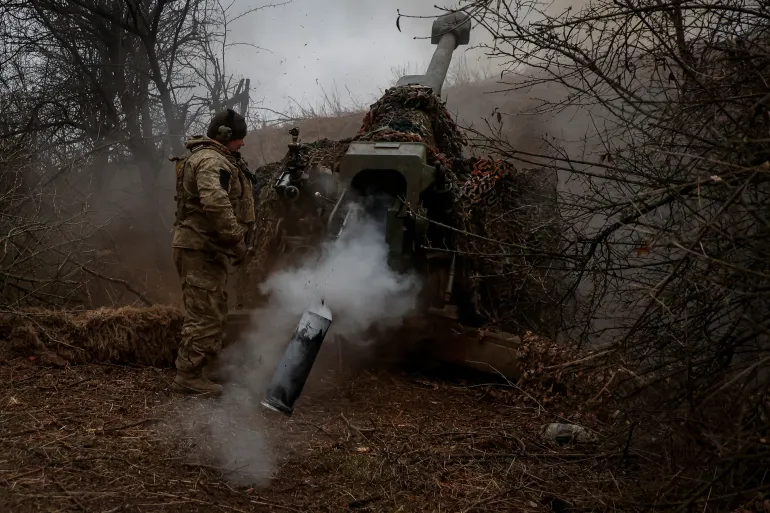Kyiv’s forces have largely succeeded in halting a four-week advance, even as pro-Ukrainian Russian forces initiate cross-border attacks.
Russian rhetoric has intensified in anticipation of President Vladimir Putin’s anticipated re-election.
Putin has emphasized Moscow’s nuclear preparedness, while military correspondents have magnified skirmishes on the battlefield against Ukrainian defenders.
However, not all of Putin’s pre-election news coverage unfolded as intended.
Ukraine executed drone attacks targeting Moscow and Russian oil facilities, while anti-Kremlin fighters asserted their presence on Russian territory.
Putin’s nuclear threat on Wednesday, the second in as many weeks, was calculated. In a pre-recorded television interview, he asserted that Russia’s nuclear forces were prepared “from a military-technical standpoint,” portraying them as the most advanced globally.
Six days after Sweden officially joined NATO as its 32nd member, Putin’s remarks were relatively subdued compared to a warning issued two weeks earlier following French President Emmanuel Macron’s suggestion of potential troop deployments to Ukraine.
“On February 29,” Putin stated, “They must realize that we also possess weapons capable of striking targets on their territory. All of this truly threatens a conflict involving nuclear weapons and the annihilation of civilization. Don’t they understand?”
Putin is currently seeking a third consecutive six-year term. He has engineered constitutional amendments that suspend the prohibition on serving more than two consecutive terms, effectively extending his rule until 2036. This move has drawn criticism from both Russian and Western detractors, who view his prolonged tenure as illegitimate.
In October, the Council of Europe characterized his presidency as a “de facto dictatorship” and called on its member states to “recognize Putin as illegitimate.”
Russian forces have persisted in making incremental progress on the eastern front for a fourth consecutive week following the fall of Avdiivka on February 17. However, the pace of these advancements has notably decelerated, indicating that Ukraine has been able to withstand the momentum of the Russian forces.
Recent geolocated footage on Friday revealed their entry into the village of Tonenke and their progression towards Berdychi, both located west of Avdiivka in the Donetsk region. It’s worth noting that Russian forces had already positioned themselves on the outskirts of both settlements a week earlier.
According to Ukraine’s Tavria Group of forces engaged in the area, the front line has stabilized. “The advance has effectively halted. The Russian military is making minor movements in this direction,” stated spokesperson Dmytro Lykhovyi.
In addition to the minor advances in Donetsk, Russian forces have been actively attempting to reverse Ukrainian gains west of Bakhmut. On Sunday, geolocated footage confirmed their entry into the village of Ivanivske.
Furthermore, Russian forces seized control of the village of Shevchenko, situated southeast of Donetsk city, on March 10. The following day, they made advancements in multiple locations along the front in the area.
Towards the northern section of the front, geolocated footage indicated Russian forces approaching the village of Terny from the east and reaching the outskirts of Synkivka, two settlements located in Donetsk and Kharkiv, respectively.
Overall, these advances were limited to hundreds of meters (or yards), with the frontline maintaining its general shape.
What appears to be crucial in Russia’s minor successes is the utilization of glide bombs. These are typically large conventional inertial bombs carrying 675kg (nearly 1,500lb) of explosives, equipped with fins and tails to extend their flight range and enhance accuracy. According to reports from the German tabloid Bild, Russia is currently engaged in mass production of these weapons.
Russian military sources have also reported the development of an enhanced glide bomb design this year, featuring engines and satellite guidance systems that increase its range from 40-70km to 95km (25-45 miles to 60 miles).
These powered bombs enable Russian aircraft to release them from a greater distance away from the frontline, thereby reducing their exposure to Ukrainian air defenses, which reportedly downed 15 aircraft in February and early March.
Meanwhile, Ukraine has been focused on launching strikes deep inside Russian territory while maintaining the frontline stability.
On Saturday, several explosions were documented in Rostov, located less than 100km (60 miles) from the Ukrainian border. At least one explosion was geolocated to a Beriev plant involved in repairing and refurbishing A-50 radar and reconnaissance planes. Ukraine has targeted these planes due to their surveillance of Ukrainian positions and provision of coordinates to fighter-bombers.
Russia’s Ministry of Defence claimed to have shot down all 47 drones deployed across four border regions, including Rostov.
On Tuesday, Ukraine launched another significant wave of drones, this time targeting energy infrastructure. Russia’s Defence Ministry reported shooting down 58 drones.
Governor Pavel Malkov of Ryazan stated that one drone struck the Ryazan refinery, located 180km (110 miles) southeast of Moscow and approximately 500km (310 miles) from the Ukrainian border, causing a fire.
According to Ukrainian news outlet Suspilne, Security Service sources indicated that two additional refineries, in Rostov and St Petersburg, as well as two airfields, were targeted. However, there is no evidence to suggest that these attacks were successful.
Ukraine’s military intelligence reported that pro-Ukrainian Russian forces conducted a border incursion on Tuesday, engaging in clashes with Russian forces in border villages in Belgorod and Kursk.
The Russian Volunteer Force and Freedom of Russia Legion, both anti-Putin paramilitaries, initiated their first attack on Russia in March 2023. Initially, Russian sources denied the incursion, but later claimed to have repelled it.
Regardless of its success in the past week, Ukraine has continued to employ tactics that have proven effective previously, such as targeting oil refineries and disrupting or damaging a significant portion of Russia’s Black Sea Fleet.
However, in interviews with Western media, Ukrainian fighters on the frontline have expressed concerns about shortages of ammunition, as military aid from the United States remains suspended in a Republican-controlled House of Representatives. The most recent warning came from Ukrainian servicemen featured in Germany’s Der Spiegel news magazine on Tuesday, who cautioned that they may not be able to sustain the current conditions indefinitely.
Even Ukraine’s new commander-in-chief, Oleksandr Syrskii, issued a warning on Wednesday, stating, “There is a threat of enemy units advancing deep into our battle formations.”
The Institute for the Study of War, a Washington-based think tank, noted that Ukrainian shortages of ammunition and other war materiel resulting from delays in the provision of US military assistance could potentially render the current Ukrainian front line more vulnerable than the relatively slow Russian advances in various sectors would suggest.
Ukraine’s European allies have been endeavoring to compensate for the shortfall in US support. Britain recently declared its intention to allocate $160 million towards the purchase of 10,000 drones for Ukraine.
Meanwhile, Czech officials have announced that they have secured sufficient funds from partners to acquire 300,000 artillery shells from various sources worldwide to aid Ukraine.
The Czech Republic is spearheading an initiative to locate 800,000 artillery shells outside of Europe and facilitate their delivery to Ukraine. Meanwhile, Germany, cautious of escalating tensions with Russia, has refrained from sending its medium-range Taurus missile directly to Ukraine. However, there are reports suggesting discussions regarding a plan to send these missiles to Britain, potentially as replacements for Storm Shadow missiles that Britain would then provide to Ukraine.
In response to the urgent need for military assistance, the administration of US President Joe Biden announced a shipment of $300 million in military aid, sourced from savings within the US defense budget. However, this falls short of the $60.1 billion in military aid that the US had initially planned to send in 2024, highlighting a significant gap in support for Ukraine.






